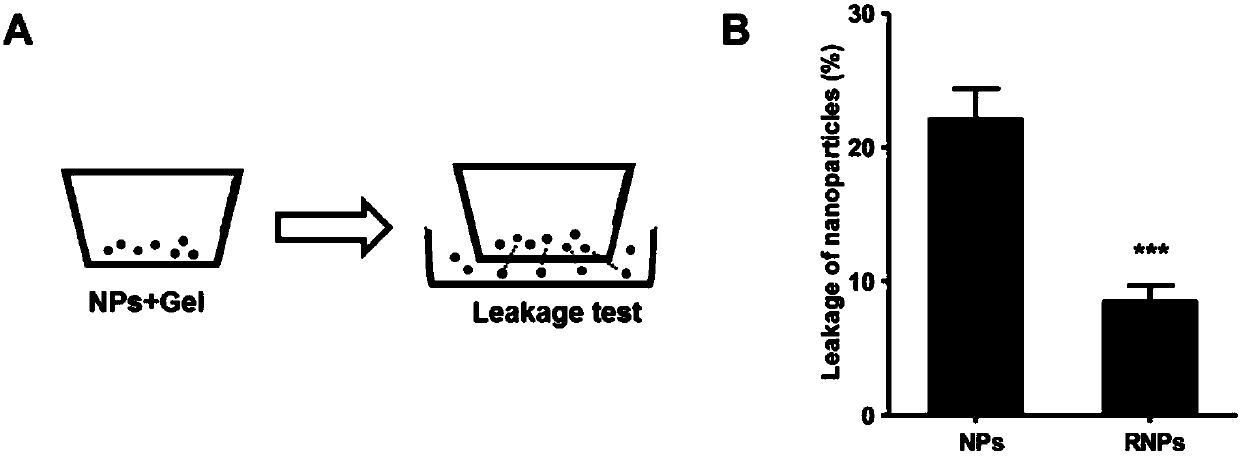Hydrogel system for anchoring nano drug carrier and use thereof in preparing drug delivery system
A nano-drug carrier and nano-carrier technology, applied in the field of biotechnology, can solve the problems of delivering immunosuppressive therapy, immobilizing drug-carrying nanoparticles, etc., to increase retention and accumulation, improve survival and therapeutic effects, reduce clear effect
- Summary
- Abstract
- Description
- Claims
- Application Information
AI Technical Summary
Problems solved by technology
Method used
Image
Examples
Embodiment 1
[0044] Example 1: Synthesis of RADA16-modified nano-drug carrier
[0045] In this example, PLGA, one of the common biodegradable polymers, is used to obtain maleimide-polyethylene glycol (Mal-PEG) modified PLGA material by modification, and the Mike addition of sulfhydryl and maleimide is used The PLGA-PEG-RADA16 material was synthesized by the reaction, and the specific operations were as follows: 5mg RADA16GGC polypeptide was dissolved in 5ml water; 50mg PLGA-PEG-Maleimide was dissolved in 5ml DMF; after mixing the two, they were stirred at 500 rpm overnight, and the free RADA16 polypeptide was removed by dialysis. , after the synthetic product was extracted with chloroform, it was obtained by drying with nitrogen to remove the solvent, and the characteristic peak of maleimide disappeared by hydrogen NMR analysis, which proved that the synthesis was successful (such as Figure 13 shown);
[0046] The preparation method of tacrolimus-loaded PLGA nanoparticles (T-RNPs) is a s...
Embodiment 2
[0048] Example 2: Evaluation of the anchoring effect of RNPs in RADA16 gel
[0049] 100 μL of RNPs were mixed with 900 μL of RADA16 solution (0.2% w / v) and injected into the Nanosight instrument. The Brownian motion was observed by Nanosight, and its drift rate was calculated. Unmodified PLGA nanoparticles (NPs) were used as a control. The results showed that the Brownian motion (1245±153nm / s) of the unmodified NPs in the gel was significantly faster than that of the RNPs (478±94nm / s), indicating that the RNPs had a slower diffusion rate and a stronger retention in the RADA16 gel. effect (such as Figure 4 shown);
[0050] The leakage results of RNPs in RADA16 gel showed that the leakage of RNPs was also significantly lower than that of unmodified NPs, which further indicated that RNPs had better anchoring effect in RADA16 gel (e.g. image 3 RNPs and RADA16 gel were injected into the leg muscles of nude mice, and the retention of RNPs at the injection site was observed at di...
Embodiment 3
[0051] Example 3: T-RNPs slow-release tacrolimus experiment in RADA16 hydrogel
[0052] 420 μg of T-RNPs were mixed with 0.3 mL of RADA16 hydrogel, placed in a 1.5 mL centrifuge tube, and 1 mL of PBS containing 0.5% (v / v) Tween 80 was added as a release medium, and the centrifuge tube was placed in a 1.5 mL centrifuge tube. At 37°C, 100 rpm, 1 mL was sampled at the sampling time point and then compensated for 1 mL of release medium. The amount of tacrolimus in the release medium was measured, which was the release amount, and the cumulative release rate was calculated. The results showed that the T-RNPs group released 77% of the tacrolimus cumulatively in 28 days, compared with the free tacrolimus group. , the release is more persistent and slow (eg Figure 5 shown in B).
PUM
| Property | Measurement | Unit |
|---|---|---|
| molecular weight | aaaaa | aaaaa |
| particle diameter | aaaaa | aaaaa |
| particle diameter | aaaaa | aaaaa |
Abstract
Description
Claims
Application Information
 Login to View More
Login to View More - R&D
- Intellectual Property
- Life Sciences
- Materials
- Tech Scout
- Unparalleled Data Quality
- Higher Quality Content
- 60% Fewer Hallucinations
Browse by: Latest US Patents, China's latest patents, Technical Efficacy Thesaurus, Application Domain, Technology Topic, Popular Technical Reports.
© 2025 PatSnap. All rights reserved.Legal|Privacy policy|Modern Slavery Act Transparency Statement|Sitemap|About US| Contact US: help@patsnap.com



